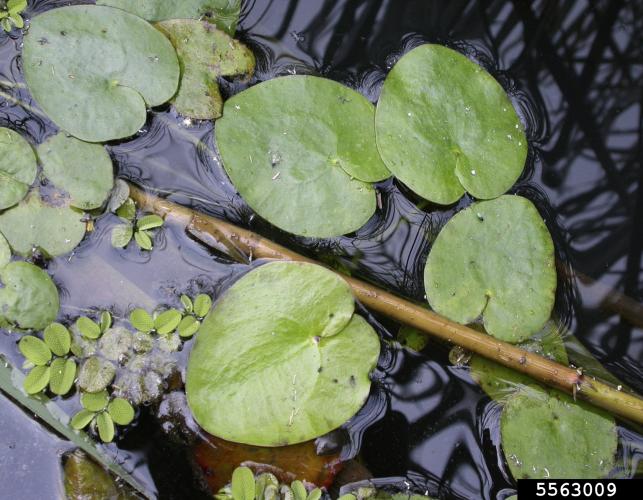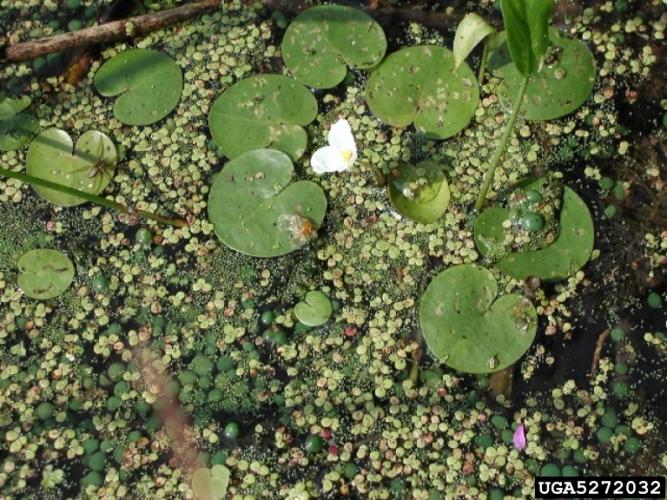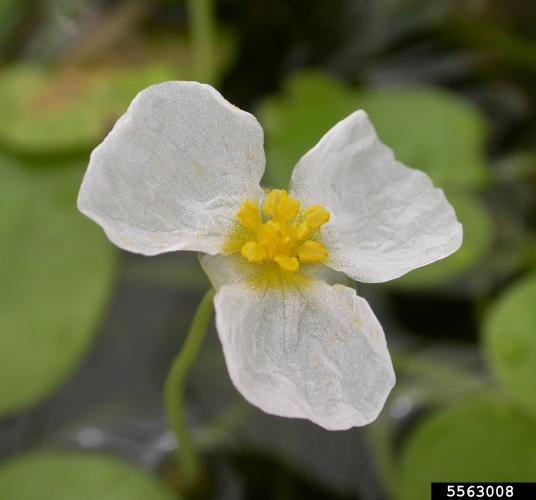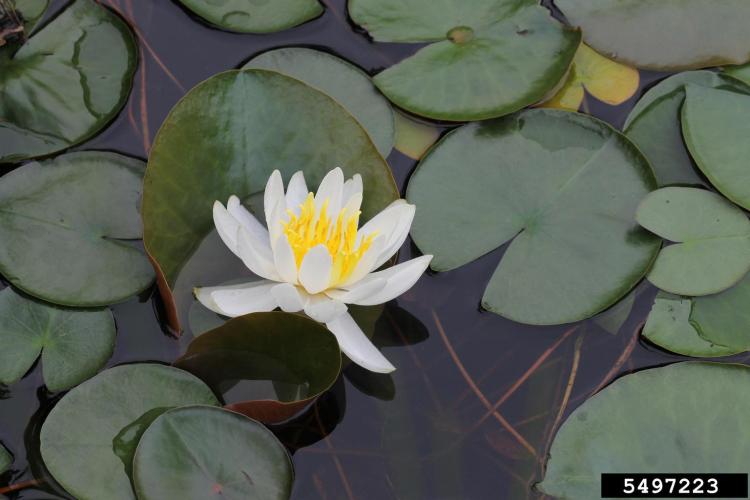Frogbit
Identification
Appearance
Frogbit is a floating aquatic plant that is found in slow-moving waters. It resembles water lilies in overall form and grows in thick mats of intertwined plants. Along with its lilyesque leaves, frogbit produces stalks and flowers that grow above the water surface.
Foliage
Frogbit leaves are heart shaped and small (2-5cm diameter). They are dark green on top, and purple on their bottom side. An individual plant can produce several leaves and grow up to 1.5m across connected by underwater root masses. These roots rarely anchor to substrate, resulting in free moving plants.
Flowers
Each frogbit plant produces a single flower. The flower is white, three petaled and grows up to 2cm. The central stamen and pistils are yellow.
Biology
Habitat
Frogbit is typically found in ponds and slow-moving waters, showing preference for protected the protected banks. It is not well adapted to nutrient poor environments, or freezing underwater temperatures, as one of its reproductive processes is temperature sensitive.
Life Cycle
Frogbit is a perennial plant. It germinates in mid-spring, and the leaves continue to grow and spread through late summer, when the plant flowers in June-August. In the fall, frogbit reproduces by dropping turions that sit dormant underwater through the winter. Come spring, these are the main reproductive means of frogbit. Frogbit is also capable of sexual reproduction, but it is diecious, and plant masses tend to be single sexed.
Ecological Threat
Frogbit can outcompete native aquatic species, spreading to form large, dense mats. This reduces plant and animal diversity where frogbit is present, as frogbit is less able to support native aquatic animals than the suite of plants it replaces. Frogbit also impacts human activities. It can impede swimming and boating activities, and has been linked to agricultural decline, when mats interfere with irrigation channels.
Vermont Distribution
Frogbit has been identified in western Vermont in Lake Champlain, Shelburne Pond, Mississquoi Bay, and the Winooski River Delta.
How You Can Help
For most aquatic invasive species, humans are the primary vector of transport from one waterbody to another. Many of these nuisance plants and animals can be unknowingly carried on fishing gear, boating equipment, or in very small amounts of water in a watercraft. The easiest and most effective means to ensure that you are not moving aquatic invasive species is to make sure that your vessel, as well as all your gear, is drained, clean, and dry.
CLEAN off any mud, plants, and animals from boat, trailer, motor and other equipment. Discard removed material in a trash receptacle or on high, dry ground where there is no danger of them washing into any water body.
DRAIN all water from boat, boat engine, and other equipment away from the water.
DRY anything that comes into contact with the water. Drying boat, trailer, and equipment in the sun for at least five days is recommended. If this is not possible, then rinse your boat, trailer parts, and other equipment with hot, high-pressure water.
Citations
Photo Credit
5272032: Leslie J. Mehrhoff, University of Connecticut, Bugwood.org
5563008, 5563009: Shaun Winterton, Aquarium and Pond Plants of the World, Edition 3, USDA APHIS PPQ, Bugwood.org
5497223: Rob Routledge, Sault College, Bugwood.org
Information Credit
“European Frogbit | Vermont Fish & Wildlife Department.” Vtfishandwildlife.com, Vermont Agency of Natural Resources, 2025, www.vtfishandwildlife.com/learn-more/landowner-resources/liep-invasive-species-program/aquatic-invasive-plants/european-frogbit. Accessed 18 June 2025.
US Fish & Wildlife Service. European Frogbit (Hydrocharis Morsus-Ranae). 2018.
USGS. “European Frogbit (Hydrocharis Morsus-Ranae) - Species Profile.” Usgs.gov, 2019, nas.er.usgs.gov/queries/FactSheet.aspx?SpeciesID=1110.



